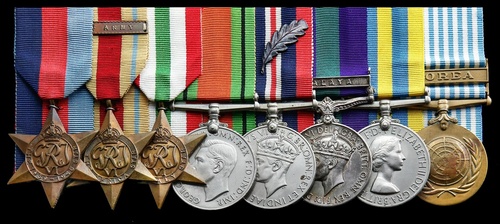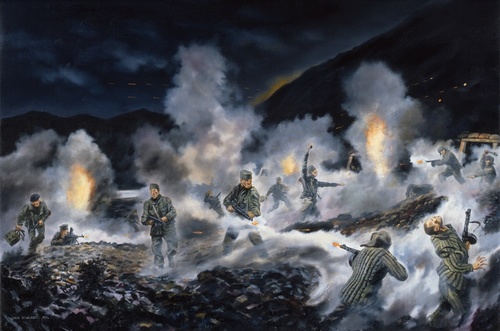Auction: 17003 - Orders, Decorations and Medals
Lot: 603
KOREA - THE HOOK:
THE ATTACK ON THE WARSAW CAVES BY 1ST KING'S
Introduction
'During their various attacks on The Hook, the Chinese had tried to reduce their casualties by digging caves ever closer and closer to our Front Line, and so shortening the distance after crossing their Start Lines before reaching our wire. There was now photographic evidence that they were doing the same thing again and getting much closer to The Hook on a feature known as 'Warsaw'. The caves were dug on their reverse slopes and so avoided our artillery and mortar fire. Brigadier Kendrew decided, therefore, that they should be destroyed and the unit to do it would be Charlie Company, 1st Battalion, King's Regiment.
On 1 June [1953] I had a call from Johnnie King-Martin to go to 1 King's and report for a briefing with Major 'Dinky' Dynes commanding Charlie Company. Major Dynes was an experienced officer who had been commissioned into the King's Regiment in 1938 and had fought with the 2nd Battalion at the bloody Battle of Cassino where his commanding officer and sixty Kingsmen had been killed. Major Dynes' plan was as follows; Charlie Company, with a detachment from 55 Field Squadron R.E. with one officer, Captain G. L. Cooper [afterwards General Sir George, G.C.B., M.C., Chief Royal Engineer] and fourteen men plus myself as Forward Observation Officer (F.O.O.), were to mount a company night attack, move out from The Hook, follow the line of Samichon River, reach the caves in three re-entrants known as 'Rip', 'Van' and 'Winkle'. A firm base consisting of the Company H.Q. and one platoon was to be established on a knoll called 'Doughnut', then three fighting patrols were to go forward to attack each re-entrant. Major Dynes told me that my job was 'to stick to him like glue.' The photos supplied by 104 A.P.I.S. were invaluable in planning our route as it was dominated on both sides by hills held by the Chinese. I carried an annotated print with me during the attack.
The next day, 2 June, was Coronation Day and it was decided that the whole divisional artillery would fire a 'Feu de Joie' from left to right with concentrations of red, white and blue smoke. Baker Troop fired white smoke, although subsequently there was an allegation that instead of white smoke, one Gun Number One had included white phosphorous … '
Chinese Hordes and Human Waves - A Personal Perspective of the Korean War 1950-1953, by Brigadier Brian Parritt, C.B.E., refers.
The operation commences
'At 2200 hrs. on 4 June we moved down from The Hook following a route that had been cleared earlier by the Assault Pioneer. It was dark with no stars. Knowing that there were a great number of mines scattered over the Samichon Valley, we moved as quietly as possible in single-file along an ill-defined path. Suddenly there was a noise from the flank and I drew my revolver feeling very vulnerable. It was quite a relief when a deer scampered past the company commander. A little later, a King's man stepped on a jumping mine which detonated, killing three soldiers next to me and wounding eleven others. As I lay on the ground, my first thought was, 'Well it has happened but I'm all right.' I could feel wetness on my left leg but nothing serious. After checking that Gunner Lake was OK we moved back to join the company commander.
The casualties disrupted the original plan to have three assaulting teams, so the company commander very sensibly decided to concentrate all his force and attack only on the main re-entrant - 'Rip'. I asked him whether I should join this attacking group but was told to stay where I was. With the noise of grenades and the mine explosion, the Chinese were now well aware something was happening and fire came down from our flanks … ' (ibid)
The attack goes in
'As the attack group advanced, I gradually moved the fire targets towards the top of the 'Rip' re-entrant, and on a signal from the company commander that the assault was in position, moved the targets to the rear. Second Lieutenant Williams led the assault and reached the caves, which were about 100 yards up the re-entrant. They threw grenades into the first cave but at the second were met by a 'Burp' gun fired at point-blank range, followed by a grenade. Lieutenant Williams climbed to the top of this cave and killed the occupants with his hand grenades. In Major Austin's account of this attack he states:
"By this time the enemy had been alerted and the re-entrant was humming like a disturbed hornets' nest. The Chinese were firing automatic weapons and rolling grenades down the steep sides. Many of the raiding party were wounded and soon only the commander and three men including one sapper were left unwounded. Lieutenant Williams decided to withdraw and ordered all but the sapper and himself to help the wounded. The sapper blew up the cave and Lieutenant Williams remained behind to help another badly wounded sapper. He got the wounded sapper back to the F.U.P. but it was under mortar fire so he decided to lie up in the paddy with the sapper and get him back when the opportunity presented itself. Fortunately, Lieutenant Cross took a small rescue party back to find him and escorted them both safely back." ' (ibid)
In total three soldiers were killed and a further 27 wounded, among the latter 'Dinky' Dynes and Brian Parritt.
The outstanding Second World War and Korean War group of eight awarded to Major M. H. M 'Dinky' Dynes, The King's Regiment, who was wounded in both conflicts and fought as a Company Commander at no less than seven actions that qualified his regiment for 'Battle Honours': the attack on the Warsaw Caves was named in his honour - Operation "Dinky"
1939-45 Star; Africa Star, clasp, 1st Army; Italy Star; Defence and War Medals, M.I.D. oak leaf; General Service 1918-62, 1 clasp, Malaya (Major M. H. M. Dynes, Kings); Korea 1950-53 (Major H. M. McL. Dynes, Kings); U.N. Korea 1950-54, initials corrected on the second to last, generally good very fine (8)
Melville Hope McLaren Dynes - popularly known as 'Dinky' - was born in Billericay, Essex on 2 December 1913, the son of Sidney and Florence Dynes.
Commissioned 2nd Lieutenant in the Leicestershire Regiment on the Special Reserve of Officers in April 1933, he transferred to the 2nd Battalion, The King's (Liverpool) Regiment as a Platoon Commander in 'B' Company in February 1935. Advanced to Lieutenant in February 1938, he otherwise distinguished himself by gaining his regimental colours as a hockey player.
With the onset of hostilities in September 1939, Dynes was appointed Adjutant of the 2nd Battalion in Gibraltar and remained similarly employed until ordered to the Middle East, where he was advanced to Captain. Having then fought in the battles of Oued Zarga, the Medjiez Plain and Tunis, and been appointed to the temporary rank of Major, he was embarked for Italy in March 1944.
Italy and Greece - first wound - M.I.D.
2nd King's subsequently took part in the desperate fighting at Monte Cassino, winning the Battle Honour 'CASSINO 11'. Then, on 11 May 1944, during the Fourth Battle of Cassino, the Battalion acted as the leading element of 28 Infantry Brigade in an opposed crossing of the River Gari. The Battalion crossed the river under sustained mortar and artillery fire and many boats capsized in the strong current. In spite of fierce and determined German opposition, and at great cost, a bridgehead was established - the Commanding Officer, Lieutenant-Colonel Garmons-Williams was mortally wounded.
2nd King's continued in the advance northwards, taking part in the battle of the Trasimene Line and, on 4 July 1944, captured the heavily defended town of Touri just south of Rome. It was in this hotly contested action that Dynes was wounded. The Battalion won a unique 'Touri' British Army Battle Honour. Moreover, in nine months of bitter fighting in difficult, mountainous terrain - and with consequent heavy casualties - the Battalion had won four D.S.O.s, nine M.C.s, three D.C.M.s and four M.M.s.
In December 1944, 2nd King's embarked for Greece, where Dynes was appointed Second-in- Command. Subsequent operations against the Communists proved challenging in the extreme: Dynes was mentioned in despatches, 'In recognition of gallant and distinguished services in Italy and Greece (London Gazette 23 May 1946, refers).
Post-war
In 1948, on the amalgamation of 1st and 2nd King's in 1948, Dynes's chances of promotion were significantly reduced. However, by way of consolation, he was personally selected by General Sir Dudley Ward, Colonel of the Regiment, to be the Officer Commanding of the King's Regimental Depot at Formby.
Then in 1951 he was posted to Kuala Lumpur, Malaya, in a staff appointment, but his tour was abruptly cut short in the following year when The King's were ordered in Korea. He was appointed a Company Commander.
Korea - Operation "Dinky" - second wound
The King's took part the several battles on The Hook, where the Chinese suffered severe casualties from the effects of our artillery firing air burst (V.T.) shells, which had a devastating effect on troops advancing over open ground. To mitigate these losses in 1953, the Chinese began to excavate caves on the reverse sides of a hill called 'Warsaw', close to The Hook, and thus reduce their casualties between leaving their 'Start Line' and reaching the forward British positions.
On the night of 4-5 June 1953, the Commonwealth Division decided to launch a company level attack - known as Operation "Dinky" - to cross No Man's Land at night and, using explosive charges, destroy these caves. Dynes, C.O. of 'C' Company, was selected to command the operation. The Company Group, which included Sappers and a Gunner F.O.O., successfully left The Hook, but then a member of Company H.Q. stepped on a 'Jumping Mine' which killed three Kingsmen and wounded 12 others. Major Dynes - although wounded by splinters in his back - reorganised the plan of attack and 2nd Lieutenant John Williams led an assault on the first cave.
By this time the caves were 'Humming like a disturbed hornets' nest' and hand-to-hand fighting ensued. Williams threw hand grenades into the first cave and the Sappers thrust in their charges. The party then withdrew carrying their wounded: Williams was awarded the M.C.
Postscript
Following his tour in Korea, Dynes returned with the Regiment to Hong Kong and, after Staff appointments in the U.K., he was placed on the Retired List in February 1958.
In the following year he married Betty Angell Stigner, who had been a 2nd Officer in the W.R.N.S. in the war, and whose first husband had been the pilot of Hudson which had been shot down by a Junkers 88 in December 1942.
In 1965 Dynes was elected Chairman of the London Branch of the King's Regimental Association and, in 1978, after moving to Devon, he was elected Chairman of the Plymouth Branch. He died on 25 September 1995, in the Kingsacre Nursing Home, Ivybridge, Devon. A distinguished and respected Kingsman, he had worn the King's Regimental cap badge for 28 years.
Subject to 20% VAT on Buyer’s Premium. For more information please view Terms and Conditions for Buyers.
Sold for
£1,200







